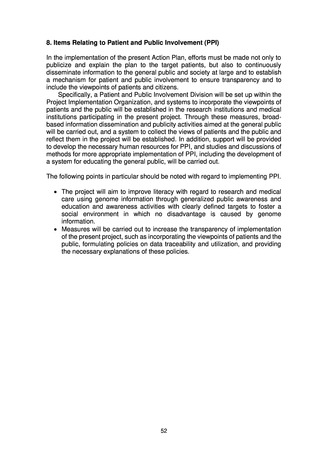よむ、つかう、まなぶ。
参考資料4_Action plan for whole genome analysis 2022 (44 ページ)
出典
| 公開元URL | https://www.mhlw.go.jp/stf/newpage_34345.html |
| 出典情報 | 厚生科学審議会 科学技術部会 全ゲノム解析等の推進に関する専門委員会(第16回 7/226)《厚生労働省》 |
ページ画像
ダウンロードした画像を利用する際は「出典情報」を明記してください。
低解像度画像をダウンロード
プレーンテキスト
資料テキストはコンピュータによる自動処理で生成されており、完全に資料と一致しない場合があります。
テキストをコピーしてご利用いただく際は資料と付け合わせてご確認ください。
FY2023, and completed within approximately three years. Modifications
to security measures, etc. will be made on an ongoing basis.
Advanced cross-sectional analysis
An analysis infrastructure (including the use of AI) that can handle
secondary analysis, including advanced cross-sectional analysis, will be
constructed. A prototype system for researchers to perform secondary
analysis will be built and verified in FY2022. This will use advanced cloud
computing technologies, and research studies will be carried out to
improve analysis performance. In addition, the data format will be
standardized to enable use of AI, and AI model development leading to
improvements in the accuracy of analysis based on the characteristics
of diseases and return of results to patients will be promoted in
collaboration with the different research groups. The quality and
performance of these AI models will be evaluated.
o Report preparation
Report preparation system
The Analysis and Data Center will create a prototype report preparation
system during FY2022 in collaboration with medical institutions that
return results to patients, with the aim of implementation from FY2023
onward. In this regard, the following points should be noted.
• APIs for extracting genome mutation and clinical information will be
put in place, and a framework that allows the development of a report
preparation system without being limited to one particular vendor will
be examined.
• This examination will identify issues such as the division of roles
between the Analysis and Data Center and medical institutions,
responsibility demarcation points, operational procedures such as
visual confirmation of reports and response to inquiries, and the
personnel system required for operation.
• Issues will be identified, such as the establishment of a knowledge
database to effectively use mutation information and return it to
patients, as well as the personnel system and the expertise of staff in
charge of development required for updating this database.
• For variants of unknown significance (VUSs), evaluation methods in
various forms, including machine learning and AI, will be examined.
• For clinical trials, a system will be examined that can search for
information not only in Japanese databases (University Hospital
Medical Information Network Clinical Trials Registry [UMIN-CTR],
Japic Clinical Trials Information [JapicCTI], Japan Medical
Association Center for Clinical Trials Clinical Trials Registry
[JMACCT-CTR], Japan Registry of Clinical Trials [jRCT]), but also in
the US ClinicalTrial.gov database.
The requirements for the reports themselves are as follows.
• The report will set out the clinical significance of pathogenic variants
and will include clinical trial information, etc. that reflects the clinical
information of individual patients.
43
to security measures, etc. will be made on an ongoing basis.
Advanced cross-sectional analysis
An analysis infrastructure (including the use of AI) that can handle
secondary analysis, including advanced cross-sectional analysis, will be
constructed. A prototype system for researchers to perform secondary
analysis will be built and verified in FY2022. This will use advanced cloud
computing technologies, and research studies will be carried out to
improve analysis performance. In addition, the data format will be
standardized to enable use of AI, and AI model development leading to
improvements in the accuracy of analysis based on the characteristics
of diseases and return of results to patients will be promoted in
collaboration with the different research groups. The quality and
performance of these AI models will be evaluated.
o Report preparation
Report preparation system
The Analysis and Data Center will create a prototype report preparation
system during FY2022 in collaboration with medical institutions that
return results to patients, with the aim of implementation from FY2023
onward. In this regard, the following points should be noted.
• APIs for extracting genome mutation and clinical information will be
put in place, and a framework that allows the development of a report
preparation system without being limited to one particular vendor will
be examined.
• This examination will identify issues such as the division of roles
between the Analysis and Data Center and medical institutions,
responsibility demarcation points, operational procedures such as
visual confirmation of reports and response to inquiries, and the
personnel system required for operation.
• Issues will be identified, such as the establishment of a knowledge
database to effectively use mutation information and return it to
patients, as well as the personnel system and the expertise of staff in
charge of development required for updating this database.
• For variants of unknown significance (VUSs), evaluation methods in
various forms, including machine learning and AI, will be examined.
• For clinical trials, a system will be examined that can search for
information not only in Japanese databases (University Hospital
Medical Information Network Clinical Trials Registry [UMIN-CTR],
Japic Clinical Trials Information [JapicCTI], Japan Medical
Association Center for Clinical Trials Clinical Trials Registry
[JMACCT-CTR], Japan Registry of Clinical Trials [jRCT]), but also in
the US ClinicalTrial.gov database.
The requirements for the reports themselves are as follows.
• The report will set out the clinical significance of pathogenic variants
and will include clinical trial information, etc. that reflects the clinical
information of individual patients.
43

























































